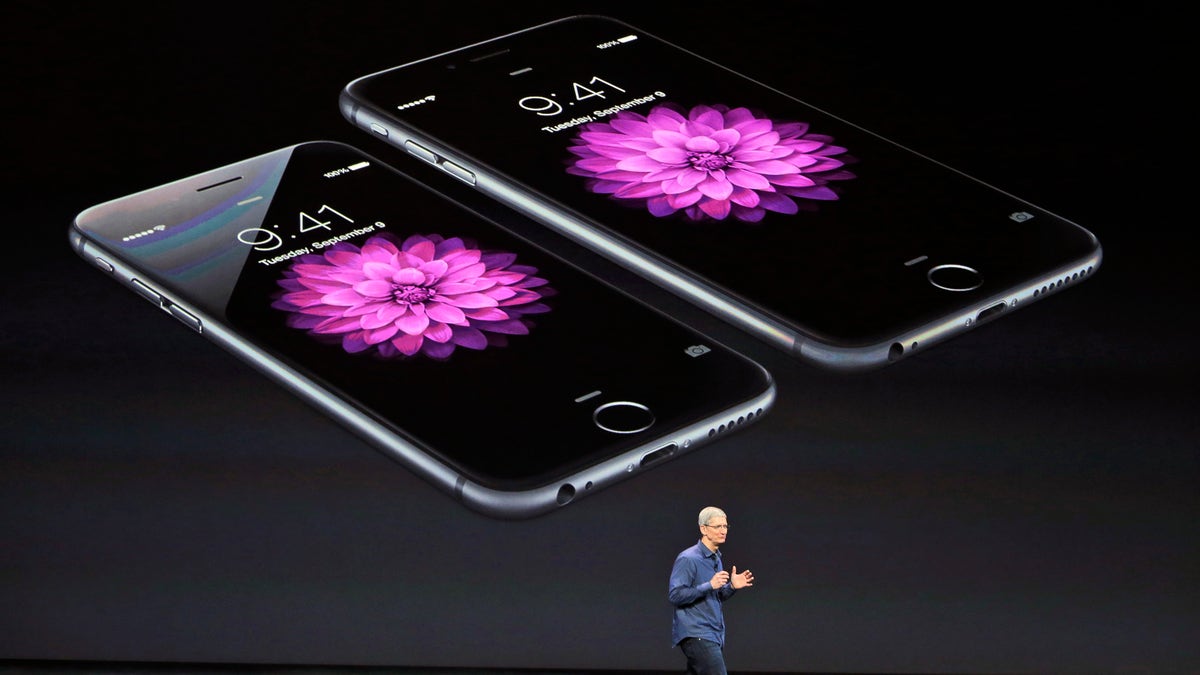
Apple CEO Tim Cook discusses the new iPhone 6 and iPhone 6 plus on Tuesday, Sept. 9, 2014, in Cupertino, Calif. The iPhone 6 will have a screen measuring 4.7 inches, while the iPhone 6 Plus will be 5.5 inches. (AP Photo/Marcio Jose Sanchez) (AP2014)
There is only one Apple Store in all of Latin America.
Just think about that. Nearly 600 million people live in a region home to the fastest-growing Internet market in the world and only one shiny white Apple store exists in Rio de Janeiro, Brazil.
To put that in perspective: there are five Apple stores in a four-mile stretch in Manhattan.
Some experts believe this shows that Apple may have a Latino problem.
A company logically only puts supply where there is demand – so many say it’s safe to assume the iPhone is not very popular south of the border. In Latin America, 80 percent of Mexicans, 86 percent of Argentinians, and 90 percent of Brazilians use Android cellphones.
In fact, more people in Mexico use Microsoft’s Windows phone than the iPhone, according to Kandar data.
Of course, one of the reasons is pricing, thanks to import tariffs. The starting price for an iPhone 5S is $958 in Brazil, home to the world’s most expensive Apple products. In the U.S. an iPhone 5S contract free is about $549. The iPad Air begins at $761 in Brazil, but in the U.S. it starts at $499. It doesn’t help, experts say, that that in Argentina, the government has all but banned the iPhone, making it clear to mobile companies that they can’t sell their products in the country unless they are made in Argentina.
But even in the United States, where there’s Apple Store galore, Latinos aren’t buying into Apple, either, even though as a whole they use smartphones and tablets more than anyone else. According to Experian Marketing Services, among Hispanics 53 percent of adults use Android and 34 percent have an iPhone – a bigger divide than among non-Hispanic adults (48 percent Android vs 38 percent iPhone).
Even the iPhone 5c, which was supposed to become a hit in Latin America because of its low cost, bombed in the region because of its higher-than-expected price.
But some analysts believe the iPhone 6 and iPhone 6 Plus could help close that Latino divide.
John Fetto, senior analyst, research and marketing at Experian Marketing Services, believes the bigger iPhone 6 and iPhone 6 Plus screens could specifically be attractive to Latinos who use their smartphones to watch video at much higher rates than the general population. During a typical week, 51 percent of Hispanic smartphone owners watch video versus 33 percent of non-Hispanics.
“It could be an influencer,” Fetto said. “With past Apple screensizes being smaller - that might have been a drawback for consuming video. The larger screen size might put Apple on a more even playing field.”
As the smartphone quickly becomes the status-quo in the mobile market around the world, Fetto says, Apple is going to have to start worrying more about market share and that means concentrating on Latin America, and Latinos in the U.S.
Apple did not return phone calls and emails seeking comment.
“Android has a higher market share around the world. Apple says they have the avid user. But that claim is becoming less powerful,” Fetto said.
Apple’s iPhone has done a great a job at attracting the early adopters of the smartphone, Fetto explained, people who really avidly use all the features on their phones. Android, meanwhile, has been the go-to phone for people who are using smartphones for the first time, as evidenced by its popularity in emerging Latin American mobile markets.
“A decent chunk of Android owners are consumers that have just upgraded from their feature phones and they are slowly starting to figure out what they are doing with their phone,” Fetto said.
The thought is as everyone becomes an avid user of the smartphone, and customers become more sophisticated, features will matter more.
Already, Latinos overall download more apps, use the Internet on their phone more, listen to more music, play more games, and use social media on their smartphones more than anyone else in the country.
But only time will tell whether iPhone 6 can convert more Latinos to Apple.
In the meantime, many Apple fans in Latin America will have to continue purchasing their iPhones in the United States and then smuggle them into their countries.
But, some say, as Latinos become more and more sophisticated smartphone users, the question becomes: Will Apple make their way into the Latino market before it’s too late?
